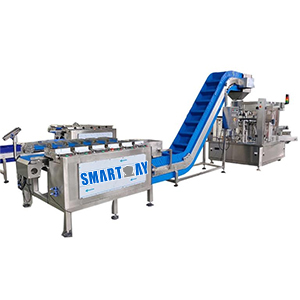A fish packaging machine is specifically designed to weigh and pack fish products efficiently and effectively while also reducing the risk of contamination and spoilage. From weighing, grading to packing, a wide variety of packaging machinery is available for different stages of fish processing. This article has discussed some of the most commonly used packaging machinery in the fish and meat industry and their key features and benefits. Please read on!
Types of Fish Packaging Machines: An Overview
有几种包装机器鱼在the market, each designed for specific tasks. Some of the most commonly used machines in the fish and meat industry include:
· The fish packaging machine
· Meat packaging machine
· Vacuum packaging machine

Fish packaging machines are specifically designed to handle fish products, including fillets, whole fish, and seafood. These machines typically feature stainless steel construction, which is resistant to corrosion and easy to clean.
On the other hand, meat packaging machines are designed for packing meat products such as beef, mutton, and chicken. They come in various capacities and sizes, from largermultihead weigherto beltcombination weigher.
Finally Vacuum packaging machines remove air from the packaging, and tightly seals which helps extend the product's shelf life and prevent contamination.
Overall, the choice of fish packaging machine will depend on the specific needs of the processor, such as the type of meat or fish being packaged, the desired packaging format, and the required production capacity.
Maintenance Tips for Fish Packaging Machines
Regular maintenance is crucial to keep fish packaging machines in optimal condition and longevity. One of the most important maintenance tasks is cleaning. Fish packaging machines should be cleaned thoroughly after each use to prevent the build-up of bacteria and other contaminants. All components that touch the fish should be disassembled and washed with soap and water.
It's also important to lubricate moving parts regularly to prevent wear and tear. This can help prevent breakdowns and extend the life of the machine.
In addition, all electrical components should be checked regularly for damage and wear, and any faulty parts should be repaired or replaced promptly.
Moreover, it is imperative to follow the manufacturer's guidelines for maintenance, which may include specific schedules for replacing parts, such as belts or blades.
Finally, operators should be trained to use and maintain the machine to ensure it is operated correctly and safely. By following these maintenance tips, fish packaging machines can work efficiently and reliably, helping to ensure product quality and safety.
Considerations When Choosing a Fish Packaging Machine
When choosing a fish packaging machine, several important factors must be considered. First, you need to consider the fish or seafood product you will be packaging. Different types of fish require different packaging methods, and the right machine will depend on the type of product you will be processing. For example, if you are packaging whole fish, you will need a machine that can handle the size and weight of the product. Additionally, you may need to consider the packaging materials used, such as vacuum bags.
Another important consideration is the production capacity of the machine. If you have a high-volume processing operation, you will need a machine to keep up with demand. On the other hand, if you have a smaller operation, a beltlinear combination weighermachine may be sufficient.
The cost of the machine is also an important factor to consider. While it may be tempting to choose a cheaper option, it's important to remember that the machine's quality will directly affect your product's quality. Choosing a high-quality machine built to last saves you capital in the long run by reducing the need for repairs and replacements.
Finally, it's important to consider the machine's ease of use and maintenance. Look for a user-friendly machine that is easy to clean, with clear instructions and accessible components.
By considering these factors, you can pick a fish packaging machine that meets your specific needs and helps ensure the quality and safety of your product.
Conclusion
In conclusion, choosing the right fish packaging machine is critical to ensuring the quality, safety, and efficiency of your fish and seafood processing operation. Factors to consider include the type of product being processed, production capacity, cost, and ease of use and maintenance. By selecting the right machine and properly maintaining it, you can help ensure the longevity of your equipment and the quality of your product. Thanks for the Read!
If you need a high-quality fish packaging machine, considerSmart Weigh. Smart Weigh is a trusted name in the industry with various options and a commitment to quality and customer service. Contact us now to learn more about our products and how we can help you find the perfect solution for your fish and seafood processing needs. Thanks for the Read!

Copyright © Guangdong Smartweigh Packaging Machinery Co., Ltd. | All Rights Reserved